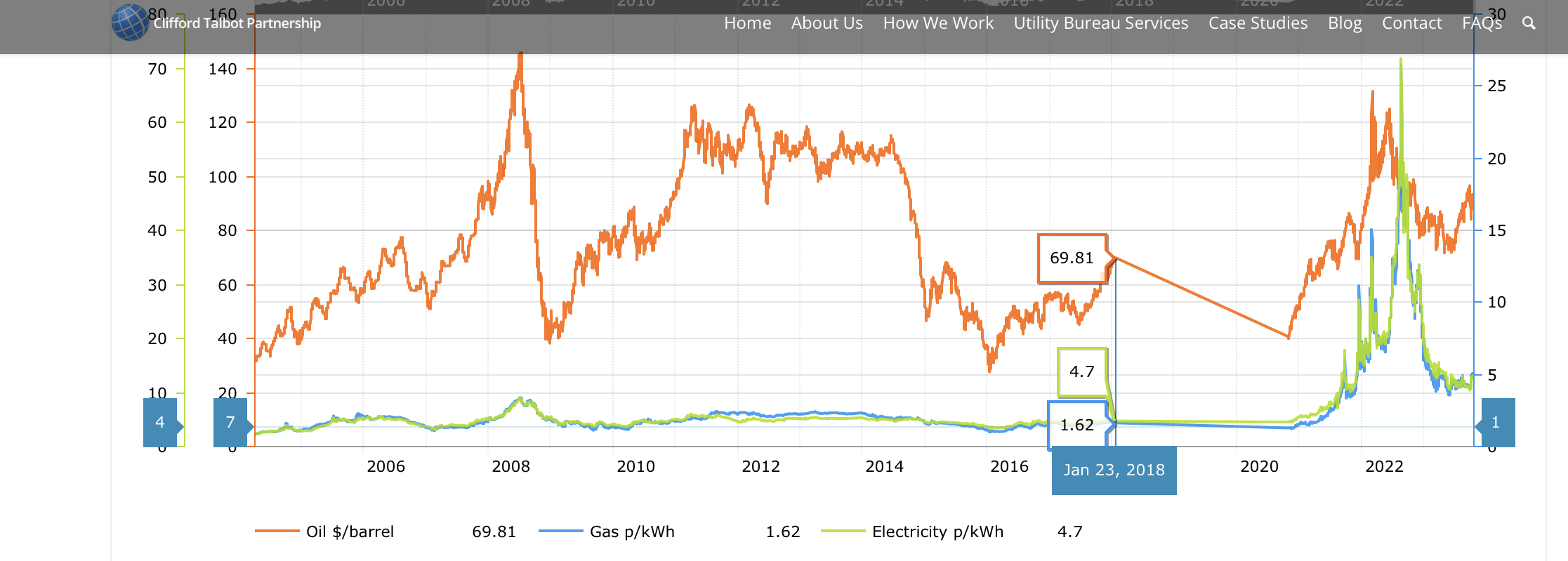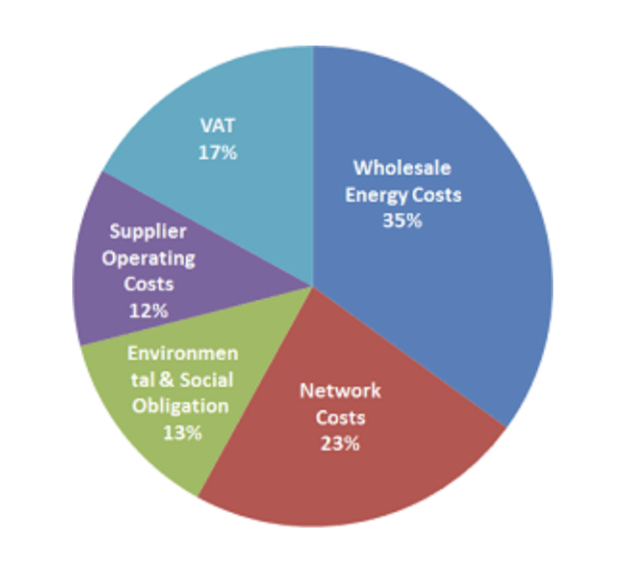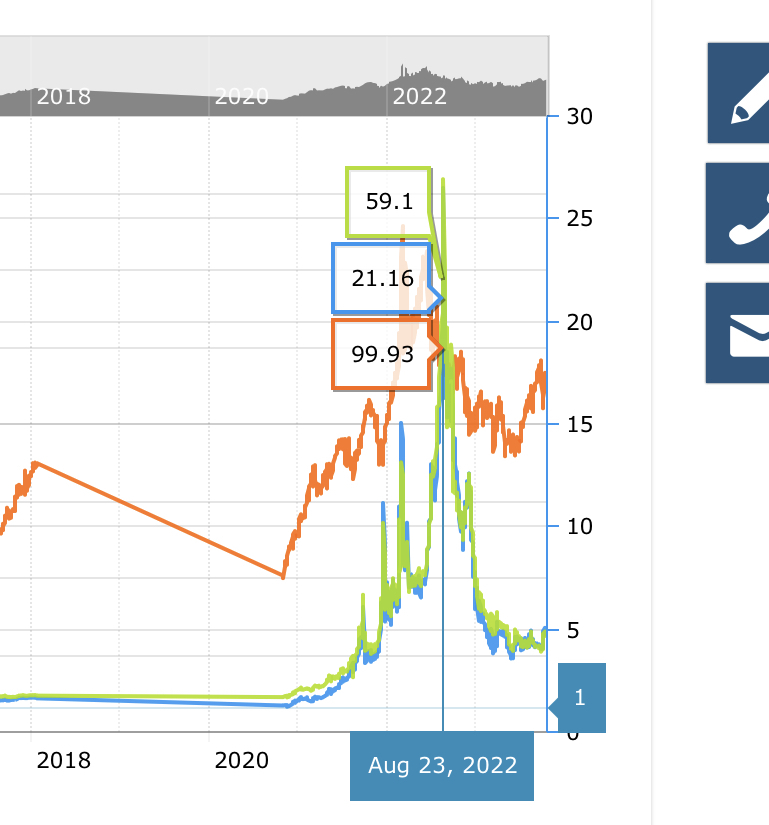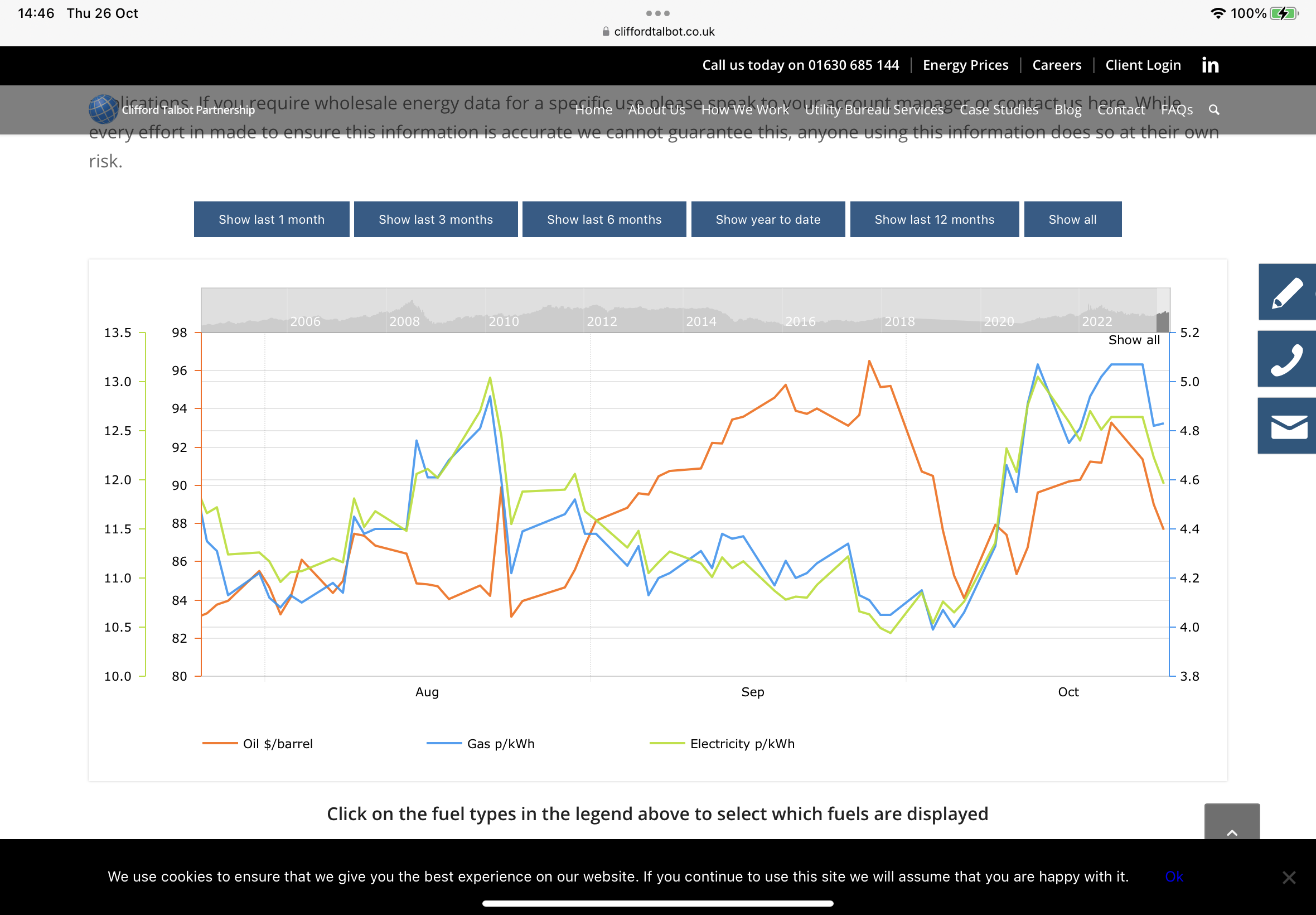We’d like to remind Forumites to please avoid political debate on the Forum.
This is to keep it a safe and useful space for MoneySaving discussions. Threads that are – or become – political in nature may be removed in line with the Forum’s rules. Thank you for your understanding.
The Alternative Green Energy Thread
Comments
-
There is a supply squeeze on turbines as every country tries to get on board with wind at the same time pushing up prices. I wonder if it makes sense for the UK to lock in lots of generation at the current inflated prices or wait until more supply comes on line and prices fall back - a bit like how buying an EV is a much better deal now than it was 12 months ago.JKenH said:Electricity prices ‘must rise by 70pc to pay for more wind farms’
No new wind farms will be built off Britain’s shores unless the Government lets operators earn more money from the electricity they produce, the chief of the nation’s biggest generator has said.
Tom Glover, country chair of RWE’s UK arm, said the price offered by the Government to wind farm operators must rise by as much as 70pc to entice companies to build.
Developers must be offered between £65 and £75 per megawatt hour (MwH) for the power generated from wind farms, Mr Glover said.
https://www.telegraph.co.uk/business/2023/10/25/electricity-prices-rise-70pc-pay-wind-farms-energy/
I think....0 -
JKenH said:
Electricity prices ‘must rise by 70pc to pay for more wind farms’
That's a seriously misleading headline!Headline meaning: the price of electricity from wind might need to increase from 50% of the current price of electricity from gas to 85% of the current price of electricity from gas, to encourage the construction of wind turbines.Casual reader's take: my electricity bill will increase by 70% to pay for wind turbines.N. Hampshire, he/him. Octopus Intelligent Go elec & Tracker gas / Vodafone BB / iD mobile. Ripple Kirk Hill Coop member.Ofgem cap table, Ofgem cap explainer. Economy 7 cap explainer. Gas vs E7 vs peak elec heating costs, Best kettle!
2.72kWp PV facing SSW installed Jan 2012. 11 x 247w panels, 3.6kw inverter. 34 MWh generated, long-term average 2.6 Os.1 -
Agree about the headline. I couldn’t find the story anywhere else so it is what it is. Where I can, I usually try and find another link rather than quote the Telegraph because of the paywall.QrizB said:JKenH said:Electricity prices ‘must rise by 70pc to pay for more wind farms’
That's a seriously misleading headline!Headline meaning: the price of electricity from wind might need to increase from 50% of the current price of electricity from gas to 85% of the current price of electricity from gas, to encourage the construction of wind turbines.Casual reader's take: my electricity bill will increase by 70% to pay for wind turbines.Given how the market price is set by gas what impact do you think a 70%higher CfD price will have on what the consumer pays? Any?Northern Lincolnshire. 7.8 kWp system, (4.2 kw west facing panels , 3.6 kw east facing), Solis inverters, Solar IBoost water heater, Mitsubishi SRK35ZS-S and SRK20ZS-S Wall Mounted Inverter Heat Pumps, ex Nissan Leaf owner)0 -
Increasing the price from £44/MWh to £65/MWh is 2.1p/kWh. A third of our electricity comes from wind so that's 0.7p/kWh on your bill... a 2.7% increase based on the price capped 26p/kWh. This of course assumes that all the wind generation will attract a CfD payment which isn't the case so the actual increase would be even lower.JKenH said:Electricity prices ‘must rise by 70pc to pay for more wind farms’
No new wind farms will be built off Britain’s shores unless the Government lets operators earn more money from the electricity they produce, the chief of the nation’s biggest generator has said.
Tom Glover, country chair of RWE’s UK arm, said the price offered by the Government to wind farm operators must rise by as much as 70pc to entice companies to build.
Developers must be offered between £65 and £75 per megawatt hour (MwH) for the power generated from wind farms, Mr Glover said.
https://www.telegraph.co.uk/business/2023/10/25/electricity-prices-rise-70pc-pay-wind-farms-energy/
With inflation at over 6% that's actually a reduction in price in real terms.
Another anti-renewable click bait headline imo.4kWp (black/black) - Sofar Inverter - SSE(141°) - 30° pitch - North LincsInstalled June 2013 - PVGIS = 3400Sofar ME3000SP Inverter & 5 x Pylontech US2000B Plus & 3 x US2000C Batteries - 19.2kWh0 -
I think it will be a bit more complicated than that.
The first point I want to make is that CfD prices are talked about in 2012 figures. £44 then was equivalent to about £60 today so the £65-75 suggested is about £89 to £102 so let’s take a midpoint price of £95/kWh. Now it is often said how much cheaper renewables are than fossil fuels (gas and coal) but if we go back to 2019 before any gas price shocks the average wholesale price/kWh was £42/kWh. Drax Electric Insights
The trend in Gas prices had been relatively stable for some time (2011 to 2020) and wholesale electricity prices the same. I apologise for the inaccessibility of prices for 2019 but in 2018 gas was 1.62p/kWh and by November 2020 1.29p and 4.53p By August 2023 the figures were 4.81 and 12.7. The latest figures are 4.75 and 12.59. The ratio varies but the wholesale electricity price tends to be around 3 x the wholesale gas price. It is absolutely clear that electricity prices are linked to gas prices. This has been a bad thing over the last couple of years but in normal time it has meant low and stable electricity prices.

Wholesale Energy Prices for Oil, Gas and Electricity - Interactive Charts
If gas prices do fall back to somewhere near normality and all the predictions have been in the past that prices will continue to fall we will likely see gas prices below or around 2p/kWh which will translate to electricity prices at around 6-7p/kWh £60 to £70/MWh or around two thirds of the cost of the proposed CfD prices sought by wind farm developers. We know that the retail cost of electricity is made up of more than the cost of generating the power, In fact wholesale power costs only account for around 35% of the electricity bill we see as consumers,so by the time we consumers get the bill that CfD price of £95/MWh has become £271 or 27p/kWh which is just what we are paying now in the middle of an energy crisis.

What Makes Up the Price of Electricity? | Business Juice
Now that may seem a little unfair as surely it is only the generating cost that will increase the electricity price. Well, that’s not how it worked in 2022. When gas shot up to 21p/kWh electricity prices went up to 59p maintaining almost the same 3 to 1 ratio. With wind output fluctuating daily and less consistent gas generation, the day to day prices will be far more unstable and the balancing costs much higher.

The other point to bear in mind is curtailment.
In 2019, wind produced 20% of our generation (58TWh or of 285TWh total from an installed capacity of 24 GW) averaging 6.64 GW (CF of 28%). By the end of 2022 it had risen to around 28GWh and produced 77TWh (27%) of our 280 TWh demand averaging 8.84 GW (CF 32%).
By early 2023 we were seeing daily wind generation exceeding 20GW or around 70% of capacity
In 2022 approximately 4TWh of electricity were curtailed.
The split between offshore and onshore wind was by now around 50% and we had roughly 14GW of offshore wind which has a CF of around40% compared to 27% for onshore wind. The plan is by 2030 to add another 36GW of offshore capacity (at a higher average CF - say 47%) as well as expanding onshore wind(I don’t have a figure for that).
By 2030 if on a very good day we have say capacity of 20 GW of onshore wind at a CF of 30% and 50GW of offshore wind at say 70% we will be producing 41 GW of wind generation on top of nuclear at say, 6GW, and some solar which is also expanding at say 8Gw generation plus the gas generators on standby we have a total of 60GW which is twice current demand. If we curtailed 5% of wind when the best generating days were only two thirds of demand one wonders how much curtailment will be needed when we have 70GW of wind.
Even with todays CF factors our 28 GWh produced 77 TWh of electricity so at say an average CF of 40% there will be enough wind to meet our entire annual demand so effectively all our other sources of generation will be surplus to requirements. We can’t get rid of our other sources of energy because ,as we have seen this year, wind generation can at times be less than 1% of installed capacity. Even if we scale back gas the likelihood is we could be curtailing 100 TWh by 2030.*
One MWh curtailed costs us £95,
One GWh £95,000
One TWh £95 million
100 TWh £9.5bn
UK households accounted for 35% of electricity consumption so assuming that 35% of that £9.5bn went on our bills that would be £337/household..
That’s just the potential extra cost of curtailment, on top of which we could expect to see domestic electricity prices maintained at their current levels rather than falling back to the levels we saw before the energy crisis.
*Ah, well what about storage and interconnectors. So far storage has failed to keep up with the roll out of wind and the parts of NW Europe to which we are connected are faced with the same weather systems we have. Windy there when it’s windy here and calm there when calm here. We have had a good run of late being able to export to France in particular with its nuclear woes but this won’t last forever and we need more interconnectors which of course involves more cost which inevitably goes onto our bills.
Edited to correct figures - I hate big numbers.
Northern Lincolnshire. 7.8 kWp system, (4.2 kw west facing panels , 3.6 kw east facing), Solis inverters, Solar IBoost water heater, Mitsubishi SRK35ZS-S and SRK20ZS-S Wall Mounted Inverter Heat Pumps, ex Nissan Leaf owner)0 -
There is a logical error in your calculation
In fact wholesale power costs only account for around 35% of the electricity bill we see as consumers, so by the time we consumers get the bill that CfD price of £95/MWh has become £271 or 27p/kWh
Your single stress point example not withstanding, this suggests the per unit price to the consumer is 3x the per unit price of generation - actually the mark up is a fixed number of pence rather than a fixed ratio. This obviously has a big impact on your overall calculations.
In addition, even at the higher prices suggested for wind (and remember these are what the industry is quoting, not tested by a real CFD auction and rather obscured by inflation - is wind deployment really 50% more costly in real terms than it was 18 months ago?!) they still remain something like 15-30% less than HPC Nuclear and even more less than any further new nuclear which is probably the real alternative given we need to move away from gas for climate change reasons.I think....0 -
You are probably right on the mark up but the electricity did track the gas price (x 3) fairly consistently over the last few years and in recent months (see chart below) so I don’t know why that should be. Octopus Agile do apply a multiplier to the wholesale price to calculate their Agile tariff.michaels said:There is a logical error in your calculation
In fact wholesale power costs only account for around 35% of the electricity bill we see as consumers, so by the time we consumers get the bill that CfD price of £95/MWh has become £271 or 27p/kWh
Your single stress point example not withstanding, this suggests the per unit price to the consumer is 3x the per unit price of generation - actually the mark up is a fixed number of pence rather than a fixed ratio. This obviously has a big impact on your overall calculations.
In addition, even at the higher prices suggested for wind (and remember these are what the industry is quoting, not tested by a real CFD auction and rather obscured by inflation - is wind deployment really 50% more costly in real terms than it was 18 months ago?!) they still remain something like 15-30% less than HPC Nuclear and even more less than any further new nuclear which is probably the real alternative given we need to move away from gas for climate change reasons.
It is the wind industry saying they can’t roll out wind power at £60/MWh. There were bids in the previous auction round below this figure but the costs apparently are more than expected. I do find it hard to believe that if wind genuinely is cheaper than gas, as is claimed so often, why it should need to be paid almost £100/MWh at current prices. Electricity prices (driven by the cost of gas generation) were well below this during the summer. Either wind is cheaper than gas or it isn’t.
Northern Lincolnshire. 7.8 kWp system, (4.2 kw west facing panels , 3.6 kw east facing), Solis inverters, Solar IBoost water heater, Mitsubishi SRK35ZS-S and SRK20ZS-S Wall Mounted Inverter Heat Pumps, ex Nissan Leaf owner)0 -
The ban on onshore wind and windfall taxes spring to mind.
4.7kwp PV split equally N and S 20° 2016.Givenergy AIO (2024)Seat Mii electric (2021). MG4 Trophy (2024).1.2kw Ripple Kirk Hill. 0.6kw Derril Water.Vaillant aroTHERM plus 5kW ASHP (2025)Gas supply capped (2025)1 -
Faulty Wind Turbines Become Germany’s €16 Billion Problem
With its biggest shareholder Siemens withdrawing support, the gas turbine and grid technology maker was forced to seek a €16 billion backstop from the government, while it’s still working on how to address the faulty turbines.To combat rivals like Denmark’s Vestas Wind Systems A/S, Siemens Energy rushed out a new onshore wind turbine, the 5.X. This proved disastrous with the device prone to breaking down because major components twist over time. Despite years of work, it still hasn’t gotten to the bottom of the problems, compounded by the industry-wide crisis battling unprofitable contracts and increasing competition from cheaper Chinese products.Northern Lincolnshire. 7.8 kWp system, (4.2 kw west facing panels , 3.6 kw east facing), Solis inverters, Solar IBoost water heater, Mitsubishi SRK35ZS-S and SRK20ZS-S Wall Mounted Inverter Heat Pumps, ex Nissan Leaf owner)0 -
I tried to make my post uncomplicated.JKenH said:I think it will be a bit more complicated than that.
The first point I want to make is that CfD prices are talked about in 2012 figures. £44 then was equivalent to about £60 today so the £65-75 suggested is about £89 to £102 so let’s take a midpoint price of £95/kWh. Now it is often said how much cheaper renewables are than fossil fuels (gas and coal) but if we go back to 2019 before any gas price shocks the average wholesale price/kWh was £42/kWh. Drax Electric Insights
The trend in Gas prices had been relatively stable for some time (2011 to 2020) and wholesale electricity prices the same. I apologise for the inaccessibility of prices for 2019 but in 2018 gas was 1.62p/kWh and by November 2020 1.29p and 4.53p By August 2023 the figures were 4.81 and 12.7. The latest figures are 4.75 and 12.59. The ratio varies but the wholesale electricity price tends to be around 3 x the wholesale gas price. It is absolutely clear that electricity prices are linked to gas prices. This has been a bad thing over the last couple of years but in normal time it has meant low and stable electricity prices.

Wholesale Energy Prices for Oil, Gas and Electricity - Interactive Charts
If gas prices do fall back to somewhere near normality and all the predictions have been in the past that prices will continue to fall we will likely see gas prices below or around 2p/kWh which will translate to electricity prices at around 6-7p/kWh £60 to £70/MWh or around two thirds of the cost of the proposed CfD prices sought by wind farm developers. We know that the retail cost of electricity is made up of more than the cost of generating the power, In fact wholesale power costs only account for around 35% of the electricity bill we see as consumers,so by the time we consumers get the bill that CfD price of £95/MWh has become £271 or 27p/kWh which is just what we are paying now in the middle of an energy crisis.

What Makes Up the Price of Electricity? | Business Juice
Now that may seem a little unfair as surely it is only the generating cost that will increase the electricity price. Well, that’s not how it worked in 2022. When gas shot up to 21p/kWh electricity prices went up to 59p maintaining almost the same 3 to 1 ratio. With wind output fluctuating daily and less consistent gas generation, the day to day prices will be far more unstable and the balancing costs much higher.

The other point to bear in mind is curtailment.
In 2019, wind produced 20% of our generation (58TWh or of 285TWh total from an installed capacity of 24 GW) averaging 6.64 GW (CF of 28%). By the end of 2022 it had risen to around 28GWh and produced 77TWh (27%) of our 280 TWh demand averaging 8.84 GW (CF 32%).
By early 2023 we were seeing daily wind generation exceeding 20GW or around 70% of capacity
In 2022 approximately 4TWh of electricity were curtailed.
The split between offshore and onshore wind was by now around 50% and we had roughly 14GW of offshore wind which has a CF of around40% compared to 27% for onshore wind. The plan is by 2030 to add another 36GW of offshore capacity (at a higher average CF - say 47%) as well as expanding onshore wind(I don’t have a figure for that).
By 2030 if on a very good day we have say capacity of 20 GW of onshore wind at a CF of 30% and 50GW of offshore wind at say 70% we will be producing 41 GW of wind generation on top of nuclear at say, 6GW, and some solar which is also expanding at say 8Gw generation plus the gas generators on standby we have a total of 60GW which is twice current demand. If we curtailed 5% of wind when the best generating days were only two thirds of demand one wonders how much curtailment will be needed when we have 70GW of wind.
Even with todays CF factors our 28 GWh produced 77 TWh of electricity so at say an average CF of 40% there will be enough wind to meet our entire annual demand so effectively all our other sources of generation will be surplus to requirements. We can’t get rid of our other sources of energy because ,as we have seen this year, wind generation can at times be less than 1% of installed capacity. Even if we scale back gas the likelihood is we could be curtailing 100 TWh by 2030.*
One MWh curtailed costs us £95,
One GWh £95,000
One TWh £95 million
100 TWh £9.5bn
UK households accounted for 35% of electricity consumption so assuming that 35% of that £9.5bn went on our bills that would be £337/household..
That’s just the potential extra cost of curtailment, on top of which we could expect to see domestic electricity prices maintained at their current levels rather than falling back to the levels we saw before the energy crisis.
*Ah, well what about storage and interconnectors. So far storage has failed to keep up with the roll out of wind and the parts of NW Europe to which we are connected are faced with the same weather systems we have. Windy there when it’s windy here and calm there when calm here. We have had a good run of late being able to export to France in particular with its nuclear woes but this won’t last forever and we need more interconnectors which of course involves more cost which inevitably goes onto our bills.
Edited to correct figures - I hate big numbers.

For wind power the cost of generation & distribution is the same regardless of whether the CfD price is £44, £65 or even £500/MWh. The market for the energy works separately from the CfD price which is really nothing more than an insurance scheme. The cost of that 'premium' can therefore be applied directly to our bills to asses the impact of an increase in the CfD price. My calculation has a lot of flaws, but it's a lot closer to the real truth that the 70% suggested by the headline - although the author was careful not to mention 'bills' increasing by 70%.
Overproduction is a separate argument & hinges on whether you believe our dysfunctional government(s) is capable of transitioning to heat pumps, building an adequate public charging network for EVs, building storage for hydrogen, upgrading the grid infrastructure & installing more interconnectors. If they get some or all of this wrong, the curtailment costs could be significant.4kWp (black/black) - Sofar Inverter - SSE(141°) - 30° pitch - North LincsInstalled June 2013 - PVGIS = 3400Sofar ME3000SP Inverter & 5 x Pylontech US2000B Plus & 3 x US2000C Batteries - 19.2kWh1
Confirm your email address to Create Threads and Reply

Categories
- All Categories
- 353K Banking & Borrowing
- 253.9K Reduce Debt & Boost Income
- 454.8K Spending & Discounts
- 246K Work, Benefits & Business
- 602.1K Mortgages, Homes & Bills
- 177.8K Life & Family
- 260K Travel & Transport
- 1.5M Hobbies & Leisure
- 16K Discuss & Feedback
- 37.7K Read-Only Boards





